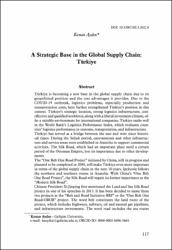| dc.description.abstract | Türkiye is becoming a new base in the global supply chain due to its
geopolitical position and the cost advantages it provides. Due to the
COVID-19 outbreak, logistics problems, especially production and
transportation costs, have further strengthened Türkiye’s position in this
context. Türkiye’s strategic location, strong logistics infrastructure, costeffective and qualifi ed workforce, along with a liberal investment climate, offer a suitable environment for international companies. Türkiye ranks well
in the World Bank’s Logistics Performance Index, which evaluates countries’ logistics performance in customs, transportation, and infrastructure.
Türkiye has served as a bridge between the east and west since historical times. During the Seljuk period, caravanserais and other infrastructure and service areas were established in Anatolia to support commercial
activities. The Silk Road, which had an important place until a certain
period of the Ottoman Empire, lost its importance due to other developments.
The “One Belt One Road Project” initiated by China, still in progress and
planned to be completed in 2049, will make Türkiye even more important
in terms of the global supply chain in the next 10 years. İpekyolu follows
the northern and southern routes in Anatolia. With China’s “One Belt
One Road Project”, the Silk Road will regain its former importance as the
“Modern Silk Road”.
Chinese President Xi Jinping fi rst mentioned the Land and Sea Silk Road
project in one of his speeches in 2013. It has been decided to name these
two projects as the “Belt and Road Initiative-BRI” or the “One Belt One
Road-OBOR” project. The word belt constitutes the land route of the
project, which includes highways, railways, oil and natural gas pipelines,
and infrastructure investments. The word road includes the sea routes covered by the project. The routes of these corridors are provided by multidimensional corridors in the direction of Asia-Europe instead of a single
route. Within the scope of this project, many infrastructure investments
are made in Türkiye as well. In this study, the cost advantages that Türkiye
will provide to the global supply chain will be evaluated due to both its
cost and geographical location and the infrastructure investments made. | en_US |

















